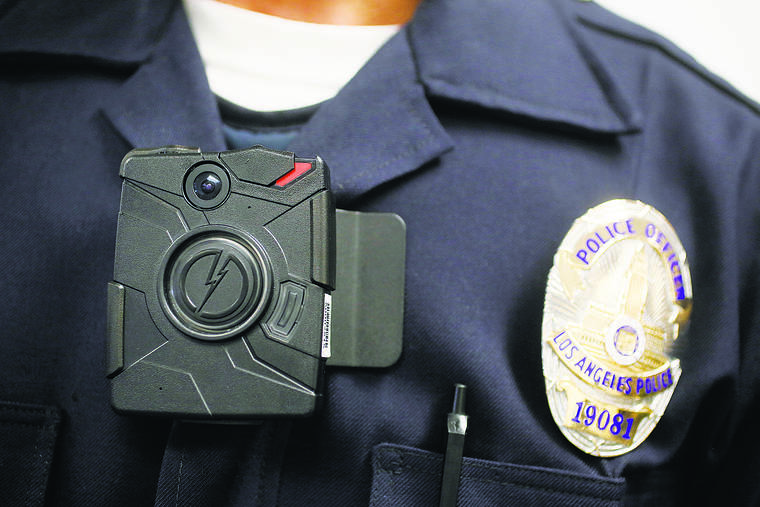KAILUA-KONA — Police Chief Paul Ferreira hopes to have Hawaii Police Department officers outfitted with body-worn cameras early next year.
With nearly $400,000 allocated in the 2019-20 Hawaii County budget for a body-worn camera program, Ferreira said the department is preparing to move forward with the procurement process to secure the 300 cameras that will be needed for uniformed patrol officers, traffic enforcement units, and specialized unit officers.
“We got a little bit delayed because of everything that has been going on,” Ferreira said in reference to law enforcement efforts amid the ongoing protest on Maunakea. “But this is a priority for us and has been a priority for some time — even before my tenure. It was just a matter of getting the funding.”
If all goes as planned, Ferreira, who’s been chief since the end of 2016, wants to roll out the program during the first quarter of 2020, sometime between January and March. An additional $200,000 will have to be budgeted each fiscal year to maintain the program.
The $400,000 in funding covers the acquisition of the cameras, storage and redaction equipment and salaries for three full-time positions to run the program. The positions include a sergeant and two information technology (IT) staff. The sergeant and one IT staffer have already been assigned and are working on the program.
“All of that is in place. Right now, we’re in the process of developing the program; we’re in the process of developing the policies,” Ferreira said.
Those policies will be very important, particularly the details about whether and when an officer shall or may use the camera; retention of footage; who can review footage and when; disclosure of footage while protecting privacy; and accountability to follow policy, said ACLU of Hawaii Policy Director Mandy Fernandes.
“The devil is really in the details of body cameras,” said Fernandes, also noting the power of the tool for promoting accountability and transparency in law enforcement as it documents interaction between officers and the public.
The community should also have some input during the policy-making process, she said.
“To my knowledge, we have not seen any sort of meaningful opportunity for the community who is going to be most effected by this to be heard,” Fernandes said of efforts to implement body-worn cameras across the state.
Ferreira said he is open to public comment as the policy is being developed. Comments and feedback can be submitted via online form at https://www.hawaiipolice.com/contact-us/feedback.
“I’m open to anything anybody has to say,” he said.
The department will also be working with the media to inform the public about the cameras, what they can and can’t do and what can and can’t be released as the program roll-out nears, he said.
“You’ve got to let them know what is out there, you’ve got to make your policy known,” he said.
Hawaii County will be the last of the state’s four counties to implement a body-worn camera program though it was the first to test the cameras back in 2013 amid the tenure of former Police Chief Harry Kubojiri for whom Ferreira was deputy chief. The department does not utilize dash cam video systems.
“They liked it. A lot of them liked it, and they looked at it in a positive way,” Ferreira said of the pilot program. Maj. Robert Wagner noted the department learned that the cameras worked well and the importance of placement location.
Though the cameras went over well, the cost of the program — which includes staff and storage, not just cameras, which are the cheaper part — made the venture too expensive to pursue amid budget constraints and no grants being awarded despite the department’s efforts to secure them.
But, this year, Mayor Harry Kim included in his budget the funding for the camera program, as well as additional positions for the department, not just for the program but for operations around the island.
The Kauai Police Department was the first to implement a body-worn camera program in 2014 followed by the Maui Police Department in 2017. The Honolulu Police Department started outfitting its officers last August with the hope of all 1,200 having body-worn cameras by the end of this year.
While being last is often not best in the minds of most, it’s a positive in this case.
“We learned from the rest of the counties,” Ferreira said. “We learned that you don’t get the funding just for the equipment. You need the people there to monitor, to work it, to actually do the program.”
He added that the other counties are also willing to help get Hawaii County’s program off the ground by having the two staffers working to implement the program visit their departments to see what they did right and wrong.
“We’re coming in last, but we can learn from everybody else, which is real good,” Ferreira said.
Fernandes, with the ACLU of Hawaii, said she is hopeful the Hawaii County police department will have the foresight from the other departments and “use this opportunity to do it right.” It’s also important in the wake of “one of the largest corruption scandals in Hawaii state history involving the (Honolulu) chief of police and a deputy prosecutor.”
“This is an opportunity to increase public trust in police,” she said.
Malcolm Lutu, president of the State of Hawaii Organization of Police Officers, said the union, which represents officers across the state including those on the Big Island, welcomes body cameras.
“Our only concern is … that the monies allotted for the body cameras and the storage, which is the biggest issue, doesn’t affect the budget for the salaries of our police officers,” he said.

